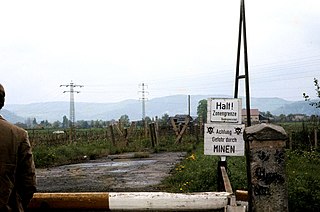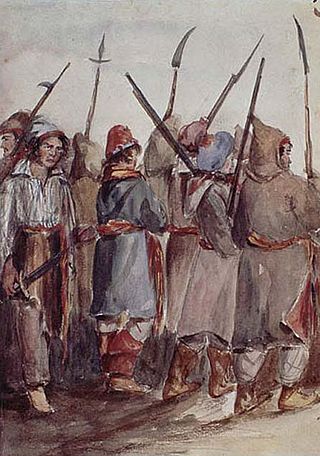
A soldier is a person who is a member of an army. A soldier can be a conscripted or volunteer enlisted person, a non-commissioned officer, a warrant officer, or an officer.
Military science is the study of military processes, institutions, and behavior, along with the study of warfare, and the theory and application of organized coercive force. It is mainly focused on theory, method, and practice of producing military capability in a manner consistent with national defense policy. Military science serves to identify the strategic, political, economic, psychological, social, operational, technological, and tactical elements necessary to sustain relative advantage of military force; and to increase the likelihood and favorable outcomes of victory in peace or during a war. Military scientists include theorists, researchers, experimental scientists, applied scientists, designers, engineers, test technicians, and other military personnel.

A military, also known collectively as an armed forces, are a heavily armed, highly organized force primarily intended for warfare. Militaries are typically authorized and maintained by a sovereign state, with their members identifiable by a distinct military uniform. They may consist of one or more military branches such as an army, navy, air force, space force, marines, or coast guard. The main task of a military is usually defined as defence of their state and its interests against external armed threats.

An area denial weapon is a defensive device used to prevent an adversary from occupying or traversing an area of land, sea or air. The specific method may not be totally effective in preventing passage, but is sufficient to severely restrict, slow down, or endanger the opponent. Some area denial weapons pose risks to civilians entering the area even long after combat has ended, and consequently are often controversial. An area denial weapon can be part of an anti-access/area denial (A2/AD) strategy.
AirLand Battle was the overall conceptual framework that formed the basis of the US Army's European warfighting doctrine from 1982 into the late 1990s. AirLand Battle emphasized close coordination between land forces acting as an aggressively maneuvering defense, and air forces attacking rear-echelon forces feeding those front line enemy forces. AirLand Battle replaced 1976's "Active Defense" doctrine, and was itself replaced by "Full Spectrum Operations" in 2001.
This is a list of words, terms, concepts, and slogans that have been or are used by the German military. Ranks and translations of nicknames for vehicles are included. Also included are some general terms from the German language found frequently in military jargon. Some terms are from the general German cultural background, others are given to show a change that was made before or after the Nazi era. Some factories that were the primary producers of military equipment, especially tanks, are also given.

Irregular military is any non-standard military component that is distinct from a country's national armed forces. Being defined by exclusion, there is significant variance in what comes under the term. It can refer to the type of military organization, or to the type of tactics used. An irregular military organization is one which is not part of the regular army organization. Without standard military unit organization, various more general names are often used; such organizations may be called a troop, group, unit, column, band, or force. Irregulars are soldiers or warriors that are members of these organizations, or are members of special military units that employ irregular military tactics. This also applies to irregular infantry and irregular cavalry units.
In warfare, a theater or theatre is an area in which important military events occur or are in progress. A theater can include the entirety of the airspace, land and sea area that is or that may potentially become involved in war operations.

Shock troops or assault troops are formations created to lead an attack. They are often better trained and equipped than other infantry and expected to take heavy casualties even in successful operations.

Dmitry Danilovich Lelyushenko (Russian: Дми́трий Дани́лович Лелюше́нко; was a Soviet military commander, the highest rank achieved being that of an Army General.

Sissi is a Finnish term for light infantry which conducts reconnaissance, sabotage and guerrilla warfare operations behind enemy lines. The word sissi, first attested in the modern meaning "patrolman, partisan, spy" in 1787, comes to Finnish from Slavic and refers either to a forest bandit or his yew bow.

Military logistics is the discipline of planning and carrying out the movement, supply, and maintenance of military forces. In its most comprehensive sense, it is those aspects or military operations that deal with:
Deep operation, also known as Soviet Deep Battle, was a military theory developed by the Soviet Union for its armed forces during the 1920s and 1930s. It was a tenet that emphasized destroying, suppressing or disorganizing enemy forces not only at the line of contact but also throughout the depth of the battlefield.

The Feldgendarmerie were a type of military police units of the armies of the Kingdom of Saxony, the German Empire and Nazi Germany until the conclusion of World War II in Europe.
Area of responsibility (AOR) is a pre-defined geographic region assigned to Combatant commanders of the Unified Command Plan (UCP), that are used to define an area with specific geographic boundaries where they have the authority to plan and conduct operations; for which a force, or component commander bears a certain responsibility. The term may also be used in other countries worldwide but it originated within the United States Armed Forces. This system is designed to allow a single commander to exercise command and control of all military forces in the AOR, regardless of their branch of service.

A rearguard or rear security is a part of a military force that protects it from attack from the rear, either during an advance or withdrawal. The term can also be used to describe forces protecting lines, such as communication lines, behind an army. Even more generally, a rearguard action may refer idiomatically to an attempt at preventing something though it is likely too late to be prevented; this idiomatic meaning may apply in either a military or non-military context.

The United States armed forces classify reconnaissance missions as "close" or "short-range"; "distant" or "medium-range"; and "deep" or "long-range".











